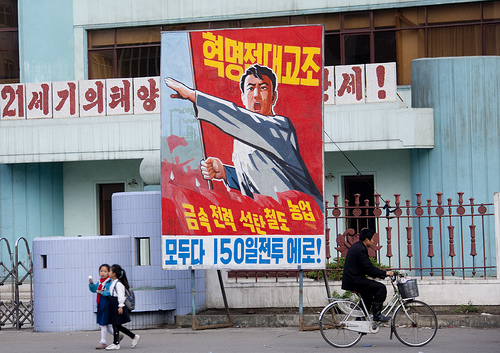According to KCNA:
Report on Implementation of 2009 Budget and 2010 Budget
Pyongyang, April 9 (KCNA) — Deputy Pak Su Gil, vice-premier and minister of Finance, delivered a report on the results of the implementation of the DPRK state budget for last year and its state budget for this year at the 2nd Session of the 12th Supreme People’s Assembly held on Friday.According to the report, the state budget for last year was successfully implemented and, as a result, the state budgetary revenue was overfulfilled 1.7 per cent, an increase of 7 per cent over the previous year.
Ministries, national institutions, management bureaus and complexes overfulfilled the national plans for budgetary revenue and all provinces, cities and counties across the country also overfulfilled their plans for local budgetary revenue.
Last year’s plan for state budgetary expenditure was carried out at 99.8 per cent.
An investment from the state budget was focused on the development of metal industry while a huge financial allocation was made for the power and coal industries and the railway transport.
8.6 per cent more funds than the previous year were spent for capital construction and expenditure was increased for agriculture and light industry.
A 7.2 per cent greater financial disbursement than the previous year was made for the field of science and technology, surpassing the level of the latest science and technology in domains of space technology, nuclear technology and CNC technology and putting the key industries of the national economy on a high scientific and technological basis.
A large amount of fund went to the field of cultural construction and 15.8 per cent of the total state budgetary expenditure was spent for national defence.
The reporter said that the scale of revenue and expenditure in the state budget for this year has been set on the principle of improving the people’s standard of living to meet the requirements of the policy of the Workers’ Party of Korea on conducting a great offensive to bring about a decisive turn in the above-said work.
This year’s plan for state budgetary revenue is expected to grow 6.3 per cent over last year. The revenue from the profits of state enterprises, the main source of state budgetary revenue, is expected to go up 7.7 per cent over last year, that from the profits of cooperative organizations 4.2 per cent, that from the fixed asset depreciation 2.5 per cent, that from real estate rent 2 per cent and that from social insurance 1.9 per cent.
This year’s plan for state budgetary expenditure is expected to show an 8.3 per cent increase over last year.
The spending for the light industry is expected to go up 10.1 per cent, that for agriculture 9.4 per cent and that for metal, power and coal industries and railway transport 7.3 per cent as compared with last year.
The expenditure for the machine-building industry is expected to go up and an 8.5 per cent bigger financial allocation will be made for scientific researches and the introduction of new technologies.
A 6.2 per cent bigger financial disbursement than last year is expected to be made to more successfully enforce the popular policies, a proof of the advantages of Korean-style socialism centered on the popular masses.
15.8 per cent of the total state budgetary expenditure for this year is expected to be spent for national defence.
It is expected that a large amount of educational aid fund and stipends will be sent for the children of Koreans in Japan this year, too.
In order to successfully implement this year’s state budget, all domains and units of the national economy should work out enterprising and realistic business strategy and management strategy and tenaciously carry them out by relying on a high degree of mental power of the producer masses and thus fulfill the plans for budgetary revenue without fail, stressed the reporter.
And according to the Choson Ilbo:
North Korean leader Kim Jong-il can freely dispose of 20 percent of his country’s budget, a former secretary of North Korean Workers’ Party has said that. Hwang Jang-yop told the Asahi Shimbun, “Only 30 percent of the budget is spent on public services, while 50 percent is earmarked for military spending.” Hwang defected to South Korea in 1997.
Hwang was interviewed by the daily during his visit to Japan on April 4-8. “Kim Jong-il’s dictatorship is 10 times worse than his father’s. People have a painful life,” he said.
Asked if the North is likely to abandon its nuclear weapons program, he said, “There is no such possibility. But the North won’t use the weapons. They’re a means to maintain the regime.”
To the question why Kim’s eldest son Jong-nam was passed over for the succession, he said, “At first, Kim Jong-il thought of choosing his eldest son as his successor. But he seems to have changed his mind as he fell in love with Ko Young-hee, the mother of Jong-un, his third son, after Jong-nam’s mother Song Hye-rim died.”
Commenting on the North’s bizarre abductions of Japanese citizens in the 1970s and 80s, he said, “The North needed native Japanese to train agents who would work in Japan.”
Read the full story here:
Kim Jong-il ‘Gets 20% of N.Korea’s Budget for His Own Use’
Choson Ilbo
4/12/2010

